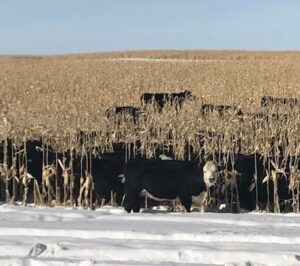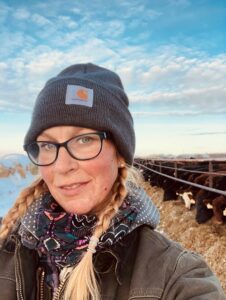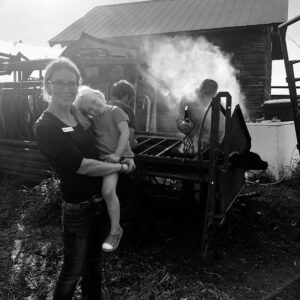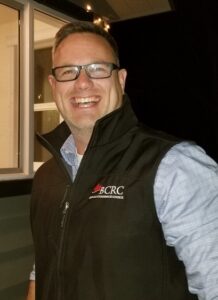Meet the Council: Thinking Outside the Box Pays Off
The Beef Cattle Research Council (BCRC) is made up of producer members from across Canada, representing and appointed by each of the provincial beef organizations that allocate part of the Canadian Beef Cattle Check-Off to research. The number of members from each province is proportional to the amount of provincial allocation to research.
The following is part three in a series to introduce you to this group of innovative thinkers that set BCRC’s direction by sharing practices, strategies, or technologies that they have integrated into their own operations. Read part one and part two of this series.
Although location and climate vary among these three producers, trying new and different systems have helped them save time and money, and enabled them to diversify their operations.
Corn Grazing to Get Cattle Through the Winter

Ryan Beierbach – Saskatchewan
Ryan and his family ranch near Whitewood, Saskatchewan, where they try to keep cattle grazing as many days of the year as possible. Cattle are selected to tolerate winter on the prairies as they strive to select easy-doing, deep and thick heifers as replacements. They use Hereford bulls on Black Angus cows then use Angus bulls on the heifers they keep as replacements.
Ryan has found that providing about three days worth of grazing at a time has helped to improve his overall pasture, and it keeps legumes like alfalfa in the stand longer as well as prevent weeds from taking over. Cattle typically graze these pastures until mid-November, then are put out on swath grazing until mid-January. From there they are moved into corn grazing until mid-March. After the cattle have consumed the corn, they are fed hay closer to home until the spring pasture is ready, which is usually in May.
At weaning, cows are sorted two ways, with most cows going into the main grazing group. A second group includes the first-calvers and bred heifers as well as any second-calvers or older cows in poorer condition. This herd is managed similar to the main grazing herd, but they are more frequently supplemented as needed with hay or other feeds to keep their condition up. The Beierbachs also ensures this group has access to stock water at all times whereas the main herd might rely on snow for a water source if conditions are right.

Choosing the right variety of corn is very important to ensure cattle don’t experience grain overload or acidosis. Ryan continues to try different varieties but chooses a high yielding variety that has higher heat unit requirements than what their area is rated for as he aims for a crop that will not reach full maturity by the time the frost hits.When turning out cows onto corn Ryan finds that they have had minimal problems with cows overloading on corn when only allowing the herd access to up to three days worth of grazing at a time. At the beginning, Ryan says they err on the side of caution and make paddocks smaller as he would rather move them in two days than give them access to too much. Ryan says “once you move them a few times you get better at guessing how much they can eat in three days.”
Ryan says limiting access and keeping cows fenced in can be a challenge as they can’t really see the fence among the corn. As a way to deal with that issue, Beirerbach’s have started to silage strips through the corn and then put up some better-quality cross fencing in a few of those strips. For this they will use wooden posts or cross laminated timber (CLT) posts and one high tensile wire, but have used two wires or aircraft cable in the past for cows they were having trouble keeping in.
When it is time to turn the cows out, they use cable reels to add additional cross fencing, preferring to “leap frog” the fences across the field so they always have one paddock built ahead of the cows. This makes fencing a bit easier as they aren’t trying to do it while the cows are ready and waiting to be moved, but also gives cattle less space to go if they do get out of the first paddock. If the previously harvested silage strips aren’t in the proper location to provide 3 days worth of grazing, Ryan will use his tractor to push over two to three bucket widths of corn to provide a space to install the fence.
With cows calving in May and June, Ryan finds the corn with occasional hay supplementation enough to meet their high energy demands. If the mature cows look like they are losing condition, Ryan will supplement the herd with an alfalfa bale to ensure their protein requirements are being met. The second group of cows with the younger and older cows will receive an alfalfa bale every time they move fences for some additional supplementation.
Easy-to-Understand Tagging Systems Make Management Easier

Joanne Solverson – Alberta
Joanne is the third generation on their family farm near Camrose, Alberta. She and her family run approximately 900 head of cattle as well as operate a small feedlot where they finish all of the calves that they don’t keep as replacement breeding stock. They grow most of the feed they use on their operation and have a small cash crop operation as well.
Cattle are out on pasture almost year-round, but they utilize community pastures to ensure they have adequate stockpiled forages for spring and fall grazing. They start heifers calving in March closer to home, but the rest of the cow herd calves on pasture in April. With a large number of cattle calving at one time, Solversons find it is important to have an easy system to identify calves. Since they choose most replacement heifers out of their own herd, as well as finish most of their cattle in their feedlot, Joanne says that having an easy-to-read tag with some general information helps with management, sorting and decision-making in the future.

At birth, all calves are given both a CCIA-approved RFID tag and a management tag and bull calves are band-castrated. Joanne works with her local farm supply store to source up to 1000 RFID tags in sequential order starting with 0001 as the first number. This allows the last digits of the RFID tag to match the calves’ management numbers.
When it comes to the management tag, heifers receive a two-piece dangle tag and steers receive a one-piece Z tag. Joanne finds the retention better with the two-piece tags, but they are more expensive. Since long term retention isn’t necessary for the steers, she opts for the lower cost tag.

Calves are numbered in the order in which they are born with heifer calves getting the last digit of the current year at the beginning of the number. For example, if a heifer is the first calf born in March of 2021, it will be 10001. This helps Joanne easily know how old a cow is when it comes to making sorting, breeding, or culling decisions. Again, because it isn’t as useful to know what year the steers are born in, those calves receive a tag with an anchor symbol in front of their number. This also helps easily identify steers and heifers just by looking at the tag during sorting. The dam’s number is included on the top of the tag. Joanne says that this is valuable if a calf is sick or in the wrong pasture as they can easily identify who the mother is if the calf needs to be brought in.
Finally, on the back of the tag they use abbreviations to note any information that might be valuable when treating, sorting, or selecting replacements. This could include identifying if the calf is a twin, a freemartin, or even information on the mother’s temperament.
Joanne says that including all of this information on the tag in a few letters and numbers has been extremely beneficial and makes day-to-day tasks, as well as major sort days, faster with less need to consult records on the fly. As Joanne’s children, ages five and three, start helping out around the farm, she enjoys watching them identify calves and start to utilize the identification system.
Raising Beef and Lumber Together

Jeff Braisher- British Columbia
Ranching near Golden, BC has provided Jeff with both challenges and opportunities. Scaling a ranch is difficult in this area due to high land prices and low purchase availability. Jeff views this as an opportunity, however, as it has forced him to think outside of the typical ranching model. Today his operation consists of four main enterprises: research and development; a seed production business; agroforestry, where they produce high-end timber; and the beef cattle ranch.
Raising both beef cattle and high-end timber might not seem like they go together, but Jeff says with proper management the systems become mutually beneficial. The trees provide shade and grazing opportunities for the cattle while the cattle help to control brush and keep out undesirable species.
Making sure the systems are synergistic involves more than just turning the cows out in the trees. On their operation they have private forestry, Crown land, and some open grassland which cattle get rotated through depending on the age and stage of the trees. Younger trees provide the best grazing land because they haven’t grown enough to have a canopy to block the sun, so grass growth is still good. But after a frost cows will often bite off the shoots of these trees causing permanent damage. Jeff tries to make sure that cattle aren’t grazing these areas in late fall.
Grazing in areas with mature trees also presents a few unique challenges. Although the trees provide shelter, if cows provide too much pressure on the trees it leaves them susceptible to insects and disease. Jeff mentions, “it is important to not have too many cattle out on those landscapes, especially in the late fall. If cattle bunch up under trees, they will trample the roots or even deposit too much manure in one spot, all of which can damage the trees.” Jeff is cautious to avoid winter feeding too close to the trees in order to avoid damage.
Jeff will rotationally graze cattle through both the treed areas and pastureland. In 2001, he spent a year working on a cattle operation in New Zealand which grazed cattle year-round. This inspired him to model his own grazing system after the low-labour system he observed in his travels.
Predators can be a challenge in their area, but Jeff says adapting their management practices have allowed for reduced problems. Jeff noticed that cow or calf kills often occurred on Sundays, a day they usually didn’t go out to the pastures. Jeff says that by making sure they are out with the cattle every day at random times, they have had reduced predator kills. Another strategy has been watching the predators that are around them to help focus on removing the culprits they know have killed cows. They try to maintain the predators that aren’t problematic in order to help prevent others from moving in. Proper and quick disposal of deadstock also helps to keep predators at bay.
Click here to subscribe to the BCRC Blog and receive email notifications when new content is posted.
The sharing or reprinting of BCRC Blog articles is welcome and encouraged. Please provide acknowledgement to the Beef Cattle Research Council, list the website address, www.BeefResearch.ca, and let us know you chose to share the article by emailing us at info@beefresearch.ca.
We welcome your questions, comments and suggestions. Contact us directly or generate public discussion by posting your thoughts below.